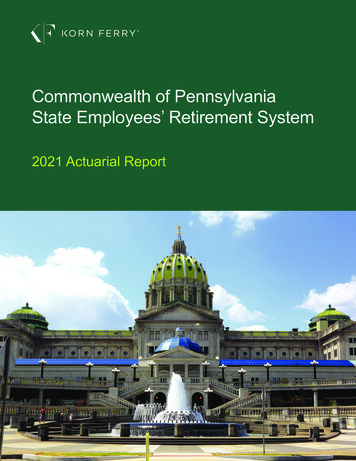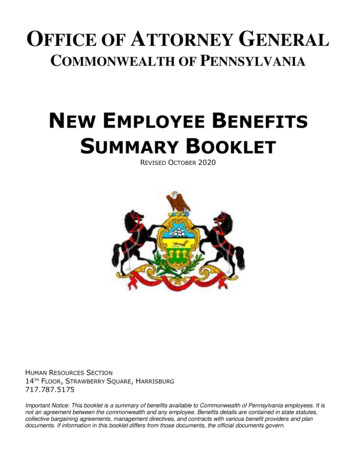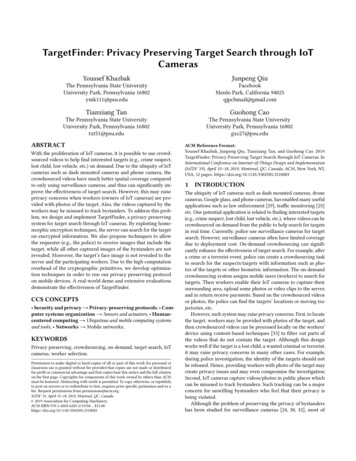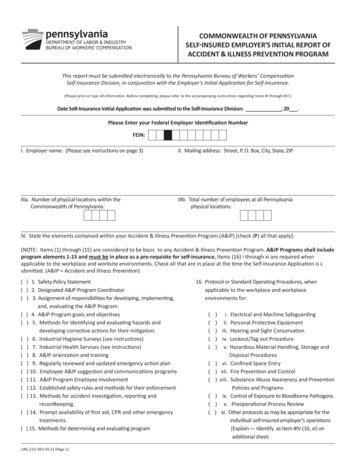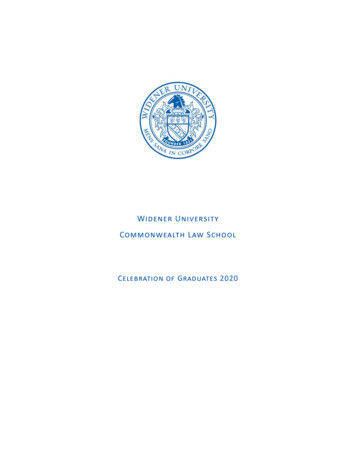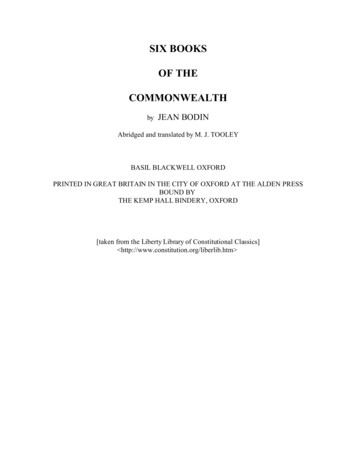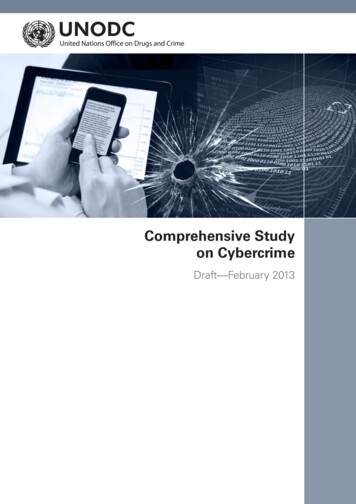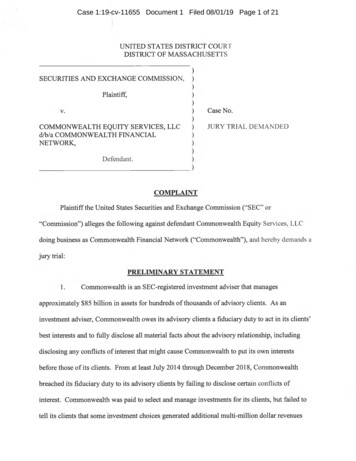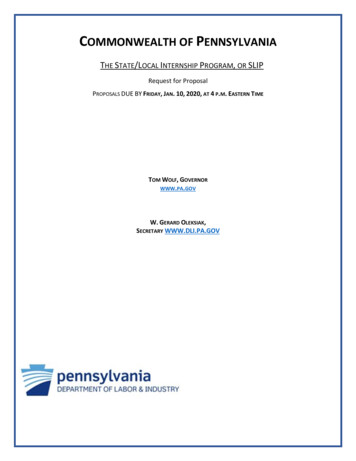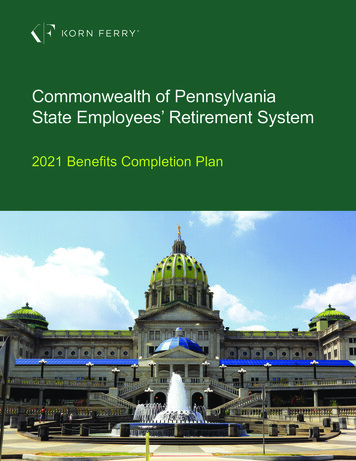
Transcription
Commonwealth of PennsylvaniaState Employees’ Retirement System %HQH¿WV &RPSOHWLRQ 3ODQ
11911 FREEDOM DRIVE, SUITE 790RESTON, VA 20190 1.703.841.3100 www.kornferry.comJune 10, 2022Mr. Joseph A. TortaExecutive DirectorState Employees’ Retirement System30 North Third Street - Suite 150Harrisburg, PA 17101-1716Dear Mr. Torta:The purpose of this letter is to recommend the amount of employer contributions necessary tosustain the Benefits Completion Plan. Section 415(b) of the Internal Revenue Code (IRC) limitsthe benefits that can be paid to members of the Pennsylvania State Employees’ Retirement System(SERS) from the SERS Defined Benefit Plan. However, pursuant to Section 415(m) of the IRCand Section 5941 of the State Employees’ Retirement Code, authority was provided to establishthe Benefits Completion Plan. The benefit from the Benefits Completion Plan is the benefit thatwould have been paid in the absence of the IRC Section 415(b) limit less the benefit that is beingpaid from the SERS Defined Benefit Plan.The December 8, 2003 Internal Revenue Service (IRS) letter ruling stated that the contribution tothe Benefits Completion Plan during each fiscal year would be limited to the amount sufficient tofund benefits payable during the calendar year that starts in the fiscal year. This report determinesthe recommended contribution for the fiscal year beginning July 1, 2022. Following the IRS letter,we have determined the contribution for the fiscal year beginning July 1, 2022 by projecting thebenefits payable from the Benefits Completion Plan fund through December 31, 2023.The Benefits Completion Plan pays both retirement annuities and death benefits. The retirementannuities are reasonably predictable. Lump sum death benefits are less predictable. Some of thedeath benefits are very large and could become payable at any time. At one extreme there couldbe no large death benefits in a year. However, there could also be one or more large death benefitspayable in any given year.In October 2006 we prepared a report on the long-term financing of the Benefits Completion Plan.Based on that report we proposed that the Benefits Completion Plan contribution be set at a highenough level to ensure that the fund was large enough to pay the two highest potential deathbenefits. Based upon this policy, our subsequent annual reviews of the status of the fund, and ourannual fund balance projections, we recommended the following contribution rates:Fiscal year beginning July 1, 2012Fiscal year beginning July 1, 2013Fiscal year beginning July 1, 2014Fiscal year beginning July 1, 2015Fiscal year beginning July 1, 20160.09 percent of payroll0.05 percent of payroll0.03 percent of payroll0.01 percent of payroll0.01 percent of payroll
Fiscal year beginning July 1, 2017Fiscal year beginning July 1, 2018Fiscal year beginning July 1, 2019Fiscal year beginning July 1, 2020Fiscal year beginning July 1, 20210.02 percent of payroll0.03 percent of payroll0.06 percent of payroll0.03 percent of payroll0.05 percent of payrollNow, based upon our review of the status of the fund as of December 31, 2021, our fund balanceprojections through December 31, 2023 and the policy described above, we recommend that SERSincrease the contribution rate to 0.06 percent of payroll for the year beginning July 1, 2022.There are currently 22 participants of the Benefits Completion Plan receiving retirement annuitypayments and 52 active employees who could potentially retire before December 31, 2023 withentitlement to Benefits Completion Plan payments. This report projects the fund based on theexpected benefits for those participants and employees.Actuarial CertificationTo the best of our knowledge, this report is complete and accurate, and all costs and liabilities havebeen determined in accordance with the applicable actuarial standards of practice and on the basisof actuarial assumptions and methods which are reasonable (taking into account the pastexperience of SERS and reasonable expectations) and which represent our best estimate ofanticipated experience under the plan.The actuaries certifying to this valuation are members of the Society of Actuaries or otherprofessional actuarial organizations and meet the General Qualification Standards of the AmericanAcademy of Actuaries for purposes of issuing Statements of Actuarial Opinion.Respectfully submitted,Korn FerryCraig R. GrabyMember American Academy of ActuariesEnrolled Actuary No. 20-73192Kristopher E. Seets, F.S.A.Member American Academy of ActuariesEnrolled Actuary No. 20-8055
Pennsylvania State Employees’ Retirement SystemBenefits Completion PlanThe Pennsylvania State Employees’ Retirement System (SERS) administers two defined benefitplans. The Defined Benefit Plan covers all eligible Pennsylvania employees and annuitants. TheBenefits Completion Plan provides benefits to certain annuitants whose Defined Benefit Planbenefits are limited by Internal Revenue Code (IRC) Section 415(b).This report presents the status of the Benefits Completion Plan as of December 31, 2021 andrecommends an employer contribution for the plan for the fiscal year beginning July 1, 2022. Theemployer contribution for the Benefits Completion Plan will be added to the employer contributionfor the Defined Benefit Plan to set the total retirement contribution for the fiscal year beginningJuly 1, 2022.Benefits Payable from the Benefits Completion Plan Trust FundIn general, IRC Section 415(b) limits a pension plan participant’s annual benefit attributable toemployer contributions to a specified dollar limit. For the 2022 calendar year, the IRC Section415(b) limit is 245,000, an increase of 15,000 over the limit in calendar year 2021.The Internal Revenue Service adjusts the IRC Section 415(b) limit for inflation on an annual basis.However, in any given year there will be no increase to the IRC Section 415(b) limit unlesscumulative inflation is enough to result in an annual increase of at least 5,000. Thus, the limitwill not necessarily increase every year.The IRC Section 415(b) limit is adjusted to its actuarial equivalence at certain pension planparticipant ages. If a participant retires before age 62, the IRC Section 415(b) limit is reduced to itsactuarial equivalent at the participant’s retirement age. If a participant retires after age 70, the IRCSection 415(b) limit is increased to its actuarial equivalent at the participant’s retirement age.The IRC Section 415(b) limit is further adjusted for the actuarial value attributable to thewithdrawal of an amount equal to the pension plan participant’s pick-up contributions withinterest. The IRC Section 415(b) limit is also adjusted actuarially for certain optional benefit formsand adjusted for annuities based on less than 10 years of service credit.The Benefits Completion Plan will pay both retirement and death benefits that exceed the IRCSection 415(b) limit. Death benefits can be paid either on the death of a retired participant receivingbenefits from the Benefits Completion Plan or on the death of an employee.Note: The terms “employee,” “member” and “participant” are used interchangeablythroughout this report; however, there are distinct differences between them. In general, an“employee” is an individual who is actively employed by the commonwealth, a “member” isan employee who is covered by the SERS defined benefit (DB) plan and a “participant” is anemployee who is covered by the SERS defined contribution (DC) plan.3
In almost all cases, SERS benefits are also limited to no more than 100 percent of compensation.In general, the Benefits Completion Plan does not pay benefits that, together with the DefinedBenefit Plan, are greater than 100 percent of compensation. An exception to this limit includescertain participants eligible for actuarial increases due to retirement beyond age 70. For suchparticipants, the 100 percent of salary limit does not apply to the actuarial increase portion of theparticipant’s benefit. For all others, the monthly retirement benefit payable from the BenefitsCompletion Plan is the difference between:1 – The total benefit that would have been paid with the 100 percent limit but without the IRCSection 415(b) limit; and,2 – The actual benefit that is paid from the Defined Benefit Plan.SERS pays a death benefit that is based on the full SERS monthly annuity without either the IRCSection 415(b) or 100 percent of pay limit, but no more than the benefit permitted under IRCSection 401(a)(9) of the Internal Revenue Code. The SERS death benefit is the total of (a) thedeath benefit based on the monthly annuity limited by 100 percent of pay and (b) a supplementalbenefit equal to the full benefit less the benefit limited by 100 percent of pay, subject to the IRCSection 401(a)(9) limits on incidental death benefits. The supplemental death benefit is payablefrom the Defined Benefit Plan to the extent permitted by IRC Section 415(b). Therefore, the deathbenefit payable from the Benefits Completion Plan is the difference between:1 – The total benefit that would have been paid without either the 100 percent limit or the IRCSection 415(b) limit; and,2 – The actual benefit that is paid from the Defined Benefit Plan.A retiree or survivor is a participant of the Benefits Completion Plan if the retiree/survivor iscurrently drawing benefits from the Benefits Completion Plan. An employee is not currently aparticipant of the Benefits Completion Plan even if the projected benefits for the employee aregreater than the IRC Section 415(b) limit. The employee will become a participant of the BenefitsCompletion Plan only after the employee retires and begins to draw benefits from the plan.Retirees/survivors who become participants of the Benefits Completion Plan will generally remainparticipants unless and until the IRC Section 415(b) limit is increased to the point that the benefitpayable to them from the Defined Benefit Plan is not limited.Monthly Retirement BenefitThe monthly benefit payable from the Benefits Completion Plan is the benefit that would have beenpaid without the IRC Section 415(b) limit, less the benefit that is being paid from the DefinedBenefit Plan. The example below illustrates the retirement benefits payable from the retirementsystem and the limits that affect the monthly benefits payable.4
Example of a Monthly Retirement Benefit Payable from the Benefits Completion PlanA.B.C.D.E.F.TABLE 1Benefit payable to the participant based onoption selected.Retirement Code 100 percent of pay limit.Retirement benefit payable from the SERSDefined Benefit Plan, limited by 100 percentof pay.(lesser of A. and B.)IRC Section 415(b) limit.Retirement benefit payable from the SERSDefined Benefit Plan, limited by IRC Section415(b) limit and 100 percent of pay.(lesser of C. and D.)Retirement benefit payable from the BenefitsCompletion Plan. e between C. and E., but not less than 0)The 100 percent of salary limit (line B. above) is applied in determining the benefit that would havebeen paid without the IRC Section 415(b) limit. Therefore, the Benefits Completion Plan and theDefined Benefit Plan, in combination, do not pay retirement benefits that exceed 100 percent offinal compensation. Although a Supplemental Death Benefit would also apply in this example, itis not being illustrated here. See Example 2 in the Appendix for an illustration of the handling ofa Supplemental Death Benefit.Death BenefitThere are three types of death benefits payable from the Benefits Completion Plan. The Appendixincludes examples of each type of benefit. The types are: Death benefits payable to beneficiaries of active participants who have an annual retirementbenefit in excess of the IRC Section 415(b) limit and who die in service (see example 1 in theAppendix); and Death benefits payable to beneficiaries of retired participants who selected Option 1 and whohave an annual retirement benefit in excess of the IRC Section 415(b) limit (see example 2 inthe Appendix); and Death benefits payable to survivor annuitants based on the optional benefit chosen by theparticipant at retirement, where the annual survivor benefit payable is in excess of the IRCSection 415(b) limit (see example 3 in the Appendix).Participants who die in service and were eligible to receive a retirement benefit are assumed tohave retired the day before death and elected an Option 1 benefit. If the Option 1 death benefit isin excess of the benefit payable under the IRC Section 415(b) limit, the Defined Benefit Plan willpay the amount of the benefit attributable to the annuity up to the IRC Section 415(b) limit, andthe Benefits Completion Plan will pay the remainder of the death benefit. Example 1 in theAppendix illustrates the death benefits payable from the SERS Defined Benefit Plan and theBenefits Completion Plan if an active participant dies in service.5
A Supplemental Death Benefit is payable to a beneficiary of a participant who had a retirementbenefit limited by 100 percent of final compensation. The Supplemental Death Benefit is thepresent value of the excess of the retirement benefit payable to the participant before applyingthe 100 percent of final compensation limit over the 100 percent of final compensation limit,subject to limits imposed by IRC Section 401(a)(9). If the benefit payable to the participant islarger than the IRC Section 415(b) limit, the part of the Supplemental Death Benefit in excess ofthe IRC Section 415(b) limit will be payable from the Benefits Completion Plan. Example 2 inthe Appendix illustrates this case.If a participant chooses a joint and survivor benefit at retirement and the benefit is limited by theIRC Section 415(b) limit (as shown in the example in Table 1), the participant will receive aretirement benefit from the SERS Defined Benefit Plan and the participant will receive aretirement benefit from the Benefits Completion Plan. It is possible that part of the survivorbenefit payable after the participant’s death would also be payable from the Benefits CompletionPlan. Example 3 in the Appendix illustrates a situation where a survivor benefit would be payablefrom the Benefits Completion Plan based on the optional benefit the participant elected atretirement. Example 4 shows a situation where a survivor benefit would not be payable. Theexamples illustrate the benefit payable based on an Option 2 (100 percent joint and survivorannuity) and an Option 3 (50 percent joint and survivor annuity).6
Status of the FundTable 2 shows the progress of the fund in calendar year 2021. The fund began at about 5,070,000and increased by 890,000 to about 5,960,000.TABLE 2Benefits Completion Plan Trust FundOperations in Calendar Year 2021Beginning Balance – December 31, 2020IncomeContributionsInvestment Income 5,066,5682,592,2582,884Total Income2,595,142ExpensesBenefit PaymentsSupplemental Benefit PaymentsRegular Benefit PaymentsBenefits PayableTotal Benefit ive Expenses11,586Total Expenses1,704,736Ending Balance – December 31, 2021 5,956,973Note: Some calculation results above may differ slightly due to rounding.Actuarial Assumptions and MethodsWith limited exceptions, as noted later in this report, the actuarial assumptions and methods usedfor this valuation of the Benefits Completion Plan are consistent with those used for the December31, 2021 actuarial valuation of the SERS Defined Benefit Plan, as described in Schedules O andP of that plan’s 2021 actuarial report. In general, these assumptions were adopted by the SERSBoard in July of 2020 based upon Korn Ferry’s review of SERS experience from 2015 through2019. The set of actuarial assumptions then adopted was fully described in Korn Ferry’s July2020 report on the Nineteenth Investigation of Actuarial Experience of the State Employees’Retirement System (which can be obtained from SERS).The Benefits Completion Plan Trust Fund will be invested in short-term investment funds in theSERS Treasury Account. Because this fund earned only 0.3 percent interest in 2020 and 0.1percent interest in 2021, a 0.0 percent interest rate was assumed for projection purposes.7
Administrative expenses include actuarial and legal fees that are charged directly to the Fund. TheFund paid 12,000 in expenses in 2021, 15,000 in expenses in 2020, 14,000 in expenses in 2019, 11,000 in expenses in 2018, and 13,000 in expenses in 2017. We assume expenses of 20,000on an annual basis.The IRC Section 415(b) limit could increase on January 1, 2023. However, for purposes of thisvaluation, it is assumed that the limit will remain flat. If the limit increases on January 1, 2023, itis likely that the benefit payments from the Benefits Completion Plan will be lower thanprojected.Assumed future salary increases will be 3.3 percent a year. The Defined Benefit Plan valuationassumes a 2.8 percent general salary increase plus a career salary increase (due to promotions andlongevity growth) that averages 1.8 percent for a total of 4.6 percent on average. The assumedcareer salary increase is inversely related to service. Because most of these employees havesubstantial service, we used a salary increase rate that was lower than the average for all years ofservice. It should be noted that the career salary increase assumptions were lowered beginningwith the 2020 valuation, due to updates resulting from the Actuarial Experience Study completedby Korn Ferry in July of 2020.To determine the liability for the Benefits Completion Plan, it is assumed that employees whoterminate and apply for an annuity before superannuation age will elect to begin benefitsimmediately. The Defined Benefit Plan valuation assumes a portion of the terminating memberswill elect a deferred benefit.For purposes of the Benefits Completion Plan valuation, it is assumed that future retiredparticipants will choose the Maximum Single Life Annuity option and will not withdraw anycontributions or interest. Assuming the participant elects a Maximum Single Life Annuityproduces a conservative estimate because the 415(b) limit is not subject to reduction when aparticipant elects to cover a spouse under a joint and survivor annuity election. When a participantwithdraws contributions and interest, under an Option 4 lump sum withdrawal, the 415(b) limitis reduced by more than the actual benefit is reduced. Therefore, one aspect of this assumption isconservative, and the other aspect is not. We believe that the net effect of these assumptionsresults in a reasonable estimate of the Benefits Completion Plan liability. The Defined BenefitPlan valuation assumes a portion of the retired members will elect an alternative form of annuity.As with the Defined Benefit Plan valuation, retirements are assumed to occur on January 1 in theBenefits Completion Plan valuation.8
Determination of the Recommended ContributionThe Benefits Completion Plan contribution is set for one year at a time based on projected payoutsfor two years. However, it is useful to consider the long-term cost of the Benefits Completion Plan.Korn Ferry (then Hay Group) estimated the projected long-term cost of the Benefits CompletionPlan in future years and presented the results in a report issued on October 6, 2006. The primaryfinding of that report was that the net Benefits Completion Plan payments, as a percent of total SERSpayroll, were projected to increase gradually to a peak of 0.05 percent of pay in 2016 to 2018. Thepayment was then expected to decline because the great majority of the Benefits Completion Planbenefits were expected to be payable to participants who joined SERS before January 1, 1996, whowould be retired or nearing retirement by 2016-2018. This was due to the fact that SERS membershired prior to 1996 do not have their compensation limited under IRC Section 401(a)(17) forpurposes of computing their benefits under both the Defined Benefit Plan and the BenefitsCompletion Plan. Most post-1995 hires, on the other hand, are subject to these IRC compensationlimits, thereby somewhat reducing the likelihood that members of this group would becomeeligible for benefits payable from the Benefits Completion Plan.In general, this trend has been accurate with occasional volatility due to the occurrence of lumpsum death benefits. The retirement annuities are reasonably predictable, but the lump sum deathbenefits are less predictable. Some of the death benefits are very large and could become payableat any time. At one extreme there could be no large death benefits in a year. However, there couldalso be one or more large death benefits payable in any given year. The lump sum death benefitshave caused most of the volatility in contribution rates to the Benefits Completion Plan.Our review of the fund as of December 31, 2020 and our fund balance projections throughDecember 31, 2022 indicated that continuing with the most recent level of funding would notsuffice for the fiscal year beginning July 1, 2021. Therefore, we recommended that the contributionrate be increased to 0.05 percent of payroll for the fiscal year beginning July 1, 2021.Our current review of the fund as of December 31, 2021 and our fund balance projections throughDecember 31, 2023 indicated that continuing with the most recent level of funding would notsuffice for the fiscal year beginning July 1, 2022. Therefore, we recommend that the contributionrate be increased to 0.06 percent of payroll for the fiscal year beginning July 1, 2022.Most of the individual participant benefits payable from the Benefits Completion Plan fund arerelatively small and predictable. However, as noted above, substantial benefits have becomepayable, and will continue to be possible, as a result of the deaths of current and potentialparticipants. Table 3 on the following page shows that six individuals have potential death benefitspayable from the Benefits Completion Plan above or approaching 1,000,000. The two largestpotential death benefits total over 7,200,000. One of these individuals is a current memberreceiving monthly benefits; the other five individuals are still active employees.9
TABLE 3Potential Death BenefitsAbove or Approaching 1 MillionPayable from the Benefits Completion Plan in 2023Employee A 4,970,000Employee B 2,320,000Employee C 1,710,000Employee D 1,670,000Employee E 1,310,000Retiree A 1,150,000Based on the projected long-term cost of the Benefits Completion Plan, Korn Ferry (then Hay Group)and SERS developed the following policy for establishing future contributions. In general, thecontribution should be set at the rate needed to build and maintain a fund sufficient to pay the twolargest potential death benefits.Therefore, the employer contribution to the Benefits Completion Plan Trust Fund is thecontribution for the year beginning July 1, 2022 that, together with the projected fund assets, willbe sufficient to fund all annuity benefits expected to be payable through December 31, 2023, plusthe two largest potential death benefits.Table 4 on the following page shows the projection of the fund balance that results from increasingto a 0.06 percent of payroll contribution rate for the 2022-2023 and 2023-2024 fiscal years. Thetable shows the projection through December 31, 2023 since the contribution needs to be sufficientto fund the benefits through 2023. The projection was made beginning with the current assets andprojections using the actuarial assumptions described above. The retirement benefits are assumedto begin on January 1. Table 4 shows a prorated share of the death benefit.The fund at the end of each period is equal to:1.2.3.4.5.The fund at the end of the prior period, plusContributions, lessRetirement and death benefits, lessExpenses, plusInvestment earnings on the fundThe retirement benefits are those projected for the period using the stated assumptions. The deathbenefits reflect actual benefits currently payable, plus other potential death benefits that areprojected using the stated assumptions. Given the low probability for each potential death benefit,the actual benefits could be zero or could be much higher if one or more of the potential high deathbenefit participants (shown in Table 3) were to die.10
Time PeriodTABLE 4Projected Benefits Completion Plan Trust Fund BalanceJune 30, 2022 Through December 31, 2023RetirementDeath BenefitContributions Benefit PaymentsPaymentsExpenses Interest -As of December 31, 2021(from Table 2 above)January 1, 2022 –June 30, 2022 1,610,395July 1, 2022 –December 31, 20221,994,788January 1, 2023 –June 30, 20231,994,788July 1, 2023 –2,050,642December 31, 2023EndingBalance 5,956,973 1,238,902 139,250 10,000 ,789Note: Some calculation results above may differ slightly due to rounding.Table 4 above shows the result of increasing to a 0.06 percent of payroll contribution rate for the2022-2023 and 2023-2024 fiscal years. The resulting fund will be more than sufficient to fund theexpected benefits using the actuarial assumptions as to the probability of retirement and mortality,and in accordance with the funding policy stated above. Barring further pre-retirement deaths fromamong those eligible for large death benefits during 2022 or 2023, by December 31, 2023, thefund will be sufficient to pay the two largest death benefits, plus there will be almost 900,000 ofadditional funds on hand to cover other potential obligations.Current and Potential Retired ParticipantsAn annuitant covered by SERS is eligible to participate in the Benefits Completion Plan if theannuitant is receiving a retirement benefit from the Defined Benefit Plan that is limited by IRCSection 415(b).Each year, as of the valuation date, the current participants in the Benefits Completion Plan areevaluated to determine if they should be included in the Benefits Completion Plan for the followingyear. Participants of the Benefits Completion Plan would not be eligible to continue to participate iftheir retirement benefit were no longer limited by IRC Section 415(b). This situation could occurif the IRC Section 415(b) limit was increased and the total benefit due to the annuitant was paidout of the Defined Benefit Plan.Current Retired ParticipantsAs of the valuation date of December 31, 2021, there were 22 participants in the BenefitsCompletion Plan when reflecting the 415(b) limit effective January 1, 2022. These 22 participantswill remain participants in the Benefits Completion Plan unless and until the IRC Section 415(b)limit is increased to the point that the benefit payable to them from the Defined Benefit Plan is notlimited.11
TABLE 5Benefits Completion PlanCurrent Retired Participants as of December 31, 2021AnnualAge GroupNumber Retirement Potential DeathBenefitBenefitLess than 655 159,316 0Older than 6517 1,283,578 1,935,053Total22 1,442,894 1,935,053Potential Retired ParticipantsIn addition to determining the liability for currently retired participants of SERS and their survivorsand beneficiaries, it is necessary to project benefits for potential participants in the BenefitsCompletion Plan. Potential participants are currently active employees of SERS who could retirebefore the end of the next calendar year with benefits limited by IRC Section 415(b).For purposes of the actuarial valuation, potential participants in the Benefits Completion Plan wereselected by SERS staff as those who had at least five years of credited service as of December 31,2021 and whose Single Life Annuity as of December 31, 2021 was more than 90 percent of theage-adjusted IRC Section 415(b) limit.These selection criteria resulted in a set of 52 employees who might receive benefits from theBenefits Completion Plan. We reviewed the selection criteria and agree that these criteria werereasonable to select all potential participants likely to receive benefits before December 31, 2022.Further, our calculation of the exact benefit for these 52 employees showed most with small orzero benefits from the Benefits Completion Plan. This confirmed our assumption that the criteriawere broad enough to identify all potential participants.Table 6 below shows the potential benefits as of December 31, 2021 for the 14 employees whocould have received a benefit if they had retired at that point. The other 38 employees, out of thetotal of 52 employees discussed above, would have received no benefit if they had retired onDecember 31, 2021.TABLE 6Benefits Completion PlanCurrent Active Employees who are Potential ParticipantsAs of December 31, 2021Age GroupCountAnnual Benefit 5050 – 5455 – 5960 – 6465 and older11156 3,2803,65219,105339,0511,115,036Total14 1,480,12412
AppendixExample 1: Lump Sum Death Benefit Payable from Benefits Completion Plan for a ParticipantWho Dies in ServiceA.B.C.D.E.F.Maximum single life annuity.IRC Section 415(b) limit.Retirement benefit payable from the SERSDefined Benefit Plan, if the participant hadretired, limited by IRC Section 415(b) limit.(lesser of A. and B.)Death benefit payable from the SERSDefined Benefit Plan is the present value ofthe benefit payable from the SERS DefinedBenefit Plan (8.0 times C).Retirement benefit payable from the BenefitsCompletion Plan, if the participant hadretired.(difference between A. and C., but not lessthan 0)Death benefit payable from the BenefitsCompletion Plan is the present value of thebenefit payable from the BenefitsCompletion Plan (8.0 times E). 250,000245,000245,0001,960,0005,00040,000Because the participant’s accrued retirement benefit is in excess of the Section 415(b) limit, adeath benefit will be paid from the Benefits Completion Plan in addition to the death benefitpayable from the SERS Defined Benefit Plan. The death benefit payable from the SERS DefinedBenefit Plan (Line D) is the present value of the retirement benefit limited by the IRC Section415(b) limit
The Pennsylvania State Employees' Retirement System (SERS) administers two defined benefit plans. The Defined Benefit Plan covers all eligible Pennsylvania employees and annuitants. The Benefits Completion Plan provides benefits to certain annuitants whose Defined Benefit Plan benefits are limited by Internal Revenue Code (IRC) Section 415(b).
